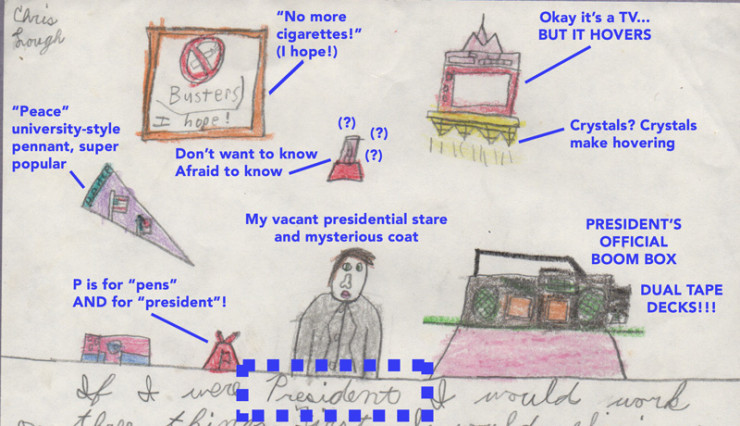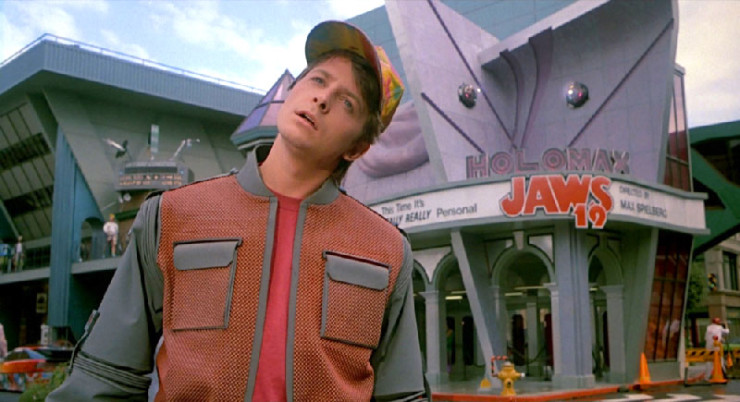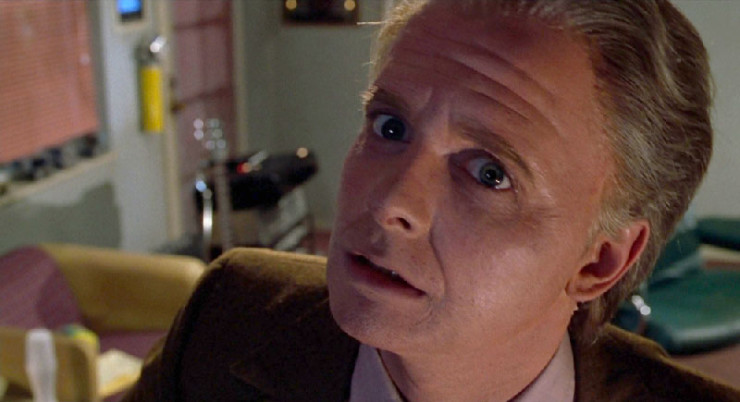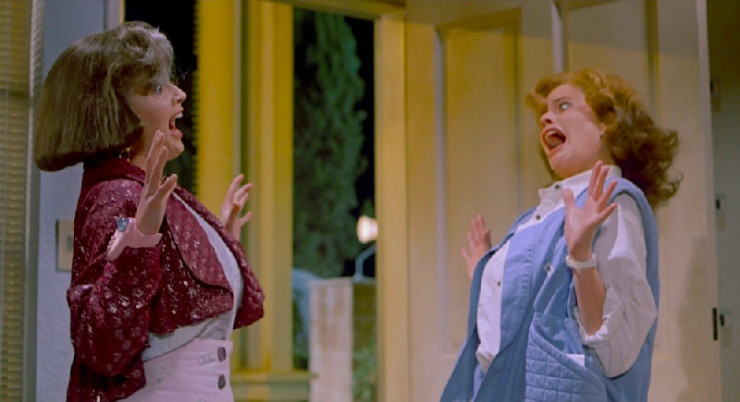I have always known that I would live to see the year 2015.
There is no logic, no magic, to this certainty. Rather, it is a testament to the effect that Back to the Future Part II had on my young self. I was in elementary school in a sun-baked Texas suburb when the movie first came out, concerned with whatever it is that third-graders are concerned with (Transformers, I think). Then suddenly… flying cars, holographic sharks, hoverboards …I was being shown my first real unquestionable glimpse of what the future held, at precisely the age where one begins to realize that the future is full of possibility. I now knew what the present day held (again, Transformers) and I knew what the impossibly distant year of 2015 was likely to hold (also Transformers, who knew?). It was only the decades in between that had yet to cohere.
The future depicted in Back to the Future Part II arguably got to me first, but even if it hadn’t I think my young mind would have been attracted to it above all other fiction. The Hill Valley of 2015 is bright, clean, and fun. It is far preferable over the sooty neon grime of Blade Runner, the robotic wasteland of Terminator, or the wide-eyed panic of pretty much anything that depicted the turn of the millennium. These are futures to escape, not strive towards.
BttF II also firmly plants its flag in an achievable time frame. For my third-grade self, 2015 was an automatic goal, easily achievable as long as I wasn’t subject to tragedy or misadventure. This was far preferable over the ideal future depicted in Star Trek and Star Trek: The Next Generation, set in distant years that I had no hope of ever seeing. The daffy splendor of Back to the Future Part II, even with all its tranqs, lobos, and zipheads, was more real than any other future.
Our family didn’t quite have the money or wherewithal to go to the movies back then, so I didn’t get to see the movie until it came out on VHS—an eternity for a ten year-old. In the interim, I attempted to satisfy my craving for the year 2015 by grilling schoolmates for plot details, reading the novelization, and apparently including drawings of things that hover in every single school assignment.

I recall that the movie both did and didn’t live up to my expectations. To be sure, 2015 was everything that I had hoped it would be. Power laces! Cool jackets! Hydrated pizzas! But young me was disappointed that the entire movie wasn’t set there, or even further into the future! The movie was called Back to the Future so why not, you know, go back…to the future?!?
Truthfully, the movie could never have satisfied my need for advance knowledge of the future, and this hunger stayed with me even as I aged up into a teenager and beyond. The focus of my predictions would change—teenage me wanted to jump forward 20 years, buy all of They Might Be Giants’ albums, then jump back, and college-age me wanted to know when his first book would be published—but I never stopped wanting to extrapolate my life forwards.
Somewhere along the way, the year 2015 became the stopping point for my incessant extrapolation. I would imagine that far, but not really any further. Sometimes this was because the year 2015 still seemed impossibly distant, but as time progressed I found that fear was increasingly my motivation for keeping 2015 as a barrier between myself and the Unknown Future. I entered my twenties at the same time that the United States devolved into a panic-stricken state, reacting to threats both imagined and real, replacing reality with rhetoric. I didn’t WANT to imagine how that kind of environment would progress further into the future, because the answer was never good.
As the 21st century marched onwards and my thirties dawned above the horizon, increasingly hairless and tired, my fear of 2015 centered more on myself. October 21, 2015 became a Day of Judgment. In 2005 I would think…well, I’ve got ten years to accomplish whatever I want to accomplish. In 2010 I would think… if you’re going to do what you’ve always wanted to do, it’s now or never. As each year passed the fear increased, regardless of the progress I had made in my life, because that meant another year had been set in stone. As a kid, I had 25 years of boisterous possibility to fill until 2015. As an adult having the majority of those years already determined was terrifying. I now knew how the future went, but unlike Marty, I couldn’t go back and change it.
Just as irrational as my belief that I would live to the year 2015 was my belief that I had wasted the time in between my elementary school years and today. And having two irrational beliefs propel you through life can give you some pretty dumb ideas about yourself. The first ideal, and this is an ideal that the entire Back to the Future series gleefully perpetuates, is that everyone has a set time limit in which to create a fulfilling life for themselves. In the first BttF film, Marty’s mother and father had 30 years. In the second film, Marty himself gets 30 years. Really, both of them get less than that, as the fate of both Marty and his dad are determined when they’re both in high school. And while high school is certainly formative, it’s not at all the only formative experience in a person’s life.
The second silly notion is thinking that you have any control over the unfolding of the future, even with access to a time machine. It’s funny…we don’t actually find out if Marty’s 2015 got better for him or his kids after his goofball hoverboard chase in the town square, or after he avoided his car crash in 1985. (A car crash that would have totally-killed-Jennifer-so-how-is-she-alive-in-the-future-but-THAT’S-a-different-article…) Probably because, as Doc cottons on to at the end of the third movie, it doesn’t matter. He nails it in a way that only a man with a hovertrain and two children named “Jules” and “Verne” can: Your future is whatever you make it.
It took nearly the entire span of time between 1985 and 2015 for me to learn the honesty of Doc’s words. I mean, I like a LOT of what happened in those years, and I don’t at all feel as if I’m done doing and saying weird things. I’m not at all where my elementary school self imagined I’d be in the year 2015, but that’s excellent. There’s no way I could have predicted who I am now, and that feels terrific.
Everything beyond the year 2015 still feels like the unpredictable future—a soft wavy sea that can never decide whether it wants to be land (yet still contains Transformers). It is as if 2015 and not 1985 is the true launching point for the capital-F Future, now that Back to the Future Part II is becoming a pleasant relic of the past. I don’t “know” what happens after 2015, but I also don’t feel a yearning to know. Not because I’m afraid of the future, but because I know there’s only so much I can do to shape it. As the timeline of the Back to the Future films reach their ultimate end, so does their influence on my life.
Still would be nice to have hoverboards, though. I guess we’ll just have to make due with cronuts, Oculus Rifts, and Tumblr.
Chris Lough writes for Tor.com and refuses to go back in time and put some money on the Cubbies. They know why.












